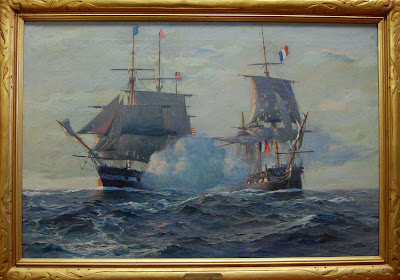Attack on USS Panay
When Japan invaded China in the summer of 1937, its armed forces
quickly moved on the capital of Nanking. By early December, it was clear that
the city could not hold out for long, and the foreigners who remained within
its limits tried desperately to flee. To aid in the evacuation of Americans,
the U.S. Navy sent the gunboat USS Panay
(PR-5), a river patrol boat assigned to the Asiatic Fleet to protect shipping
on the Yangtze River. Following the retrieval of the last American citizen, Panay moved upriver to provide armed
escort for three Standard Oil tankers.
On the afternoon of December 12, Panay and the tankers were riding at anchor with American flags
flying when they suddenly came under attack by Japanese aircraft. Three
Yokosuka B4Y Type-96 bombers and nine Nakajima A4N Type-95 fighters bombed and
strafed the four ships, sending them to the bottom of the river while killing
four people and wounding forty-eight. Small boats carrying the wounded also
came under attack.
The incident touched off a crisis between the governments of
the United States and Japan. Japanese officials maintained that it was a case
of mistaken identity, and that their pilots never spotted the American flags
each ship flew. Nevertheless, their government agreed to accept responsibility
for the attack, issued a formal apology, and paid an indemnity of $2,214,007.
This ended the crisis, though American public opinion turned sharply against
Japan in the weeks that followed.
 |
USS Panay (PR-5)
Gift of Dr. Lawrence Cohen
|
The Naval War College Museum recently received this model of
Panay as a gift from Dr. Lawrence
Cohen of Wappingers Falls, New York. Dr. Cohen built the model from scratch and
won several awards for his craftsmanship in local model building contests. We
are pleased to have it in our collection and hope to use it to educate our
visitors about the important events in Asia that preceded World War II.
 |
| Closeup of 3"/50 caliber gun mounted on bow of USS Panay Gift of Dr. Lawrence Cohen |
Rob Doane
Curator
Naval War College Museum


Comments
Post a Comment